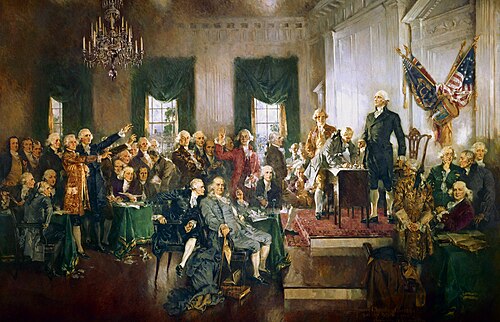Scene at the Signing of the Constitution of the United States

Scene at the Signing of the Constitution of the United States is a famous oil-on-canvas painting by Howard Chandler Christy, depicting the Constitutional Convention signing the U.S. Constitution at Independence Hall in Philadelphia. Along with Washington Crossing the Delaware by Emanuel Leutze, the painting is one of the most famous depictions of the American Revolution. Christy created the painting in April 1940. It currently is displayed along the east stairway in the House of Representatives wing in the Capitol building.
Only 39 of the 55 delegates are pictured in the painting; not included are the three delegates who did not sign the Constitution or the 13 delegates who left the convention. On the right side of the painting, on the dais, is George Washington, standing upright and signing the Constitution on a desk. The windows are open and an aura of light surrounds Washington's upper body. Above him is an American flag and drum. Behind him are James Wilson of Pennsylvania and Richard Bassett of Delaware, talking with each other. Behind them on the far right is another Delaware delegate, George Read; below them is the another Pennsylvania delegate, Robert Morris. Slightly to the right of Washington is the standing Daniel of St. Thomas Jenifer from Maryland. William Jackson, the Convention's secretary, is unusually prominent in the painting, directly in the center, standing, in red.
Sources
- Lloyd, Gordon. "About Howard Chandler Christy's Scene at the Signing of the Constitution of the United States." [1]
